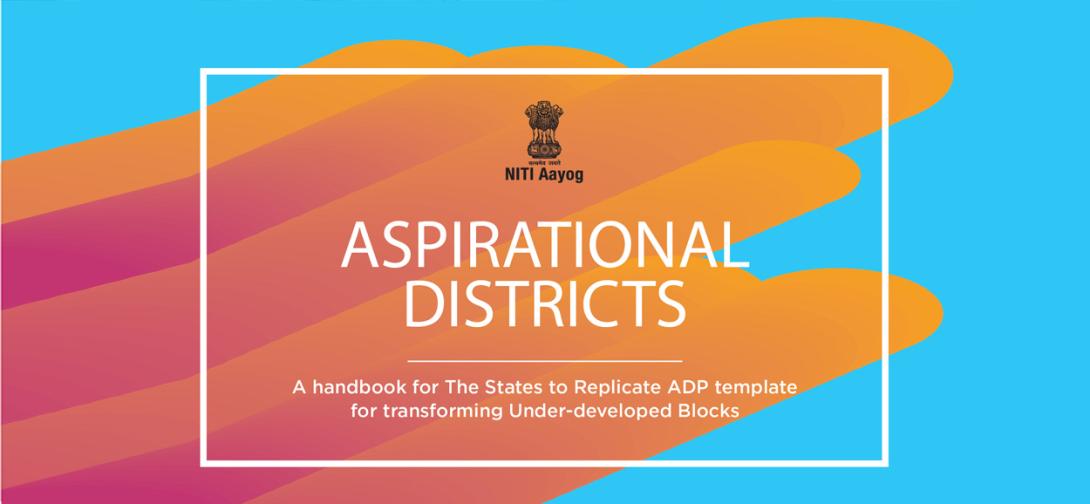Data & Aspirational Districts Model
The United Nations Development Program recently lauded the Aspirational Districts Programme (ADP) for creating significant improvements in health, nutrition, and education outcomes since the inception of the program, which happens to be the world’s largest initiative in results-based governance, reaching 250 million people in the 112 aspirational districts across India. The ADP model relies on an innovative 3C approach of competition, convergence and collaboration. By fostering competition among districts, enabling convergence of schemes, and promoting collaboration across and beyond government, the program places a razor-sharp focus on achieving results- the data on impact being available for all to see.
Data is at the very foundation of the Aspirational Districts Program. Every month, districts are ranked based on the progress that they have made on key indicators in health, education, agriculture, basic infrastructure, financial inclusion, and skills development. This opens up a realm of possibilities for policy-makers, for it not only helps in better understanding and identifying areas of intervention, but also allows for an accurate assessment of the effectiveness and impact of interventions undertaken.
When I look back upon the time when I was serving as the District Collector in Kozhikode, Kerala, it was a completely different scenario. The lack of data would severely hinder and delay the understanding of our performance in critical areas such as health, education and sanitation, besides others. We had little scope or available avenues for quantifying progress in a dynamic matter, limiting the ability to positively intervene. There was a typical lag of at least 4-5 years for any collected data to become available and thus there would be delays in the assessment and evaluation of the critical indicators pertaining to the district.
Today, the scenario has completely changed with the widespread availability of high speed internet and mobile phones. The proliferation and adoption of technology has been a game-changer in making data available in near real-time. Once these data streams are established, technology can further be used to validate and improve the quality of the data, creating the possibility of exploring the use of AI and other advanced analytical tools for deriving insight for informing decisions and improving service delivery. Ensuring the availability of high quality, granular, low cost, and real-time data on district performance is therefore a key requirement, not only for the ADP program and but for any initiative, that seeks to establish data driven governance.
In the context of data collection, there is little or no cost associated with administrative data since departments already collect such data independent of the ADP, to effectively administer their programs. In addition, this data is also collected at the most granular levels and reported at a high frequency. However, in context of data quality, there is a need to continuously monitor and strengthen administrative data. Capacity constraint related errors in data entry and aggregation, lack of standardization, skewed incentives to inflate data and other data-related issues, there is a risk that collated data does not conform to the required quality benchmarks. Without quality, data cannot serve as a meaningful signal of districts’ socioeconomic outcomes, nor can it help district authorities make evidence-driven programmatic decisions.
A rigorous and lean approach to data-driven governance
Over the last three years, the ADP has provided a scalable template for harnessing the speed, granularity, and affordability of administrative data, while strengthening data quality. We built a public dashboard to transparently display district ranks, thereby creating an important accountability mechanism. We commissioned third party household surveys to get independent district-level data on the monitored sectoral outcomes. We also built automated systems for data quality checking and worked closely with districts to address the issues that these systems detected.
In the next phase of ADP, NITI Aayog is building on these initiatives to further unlock the power of administrative data to foster systems change and improve lives on the ground. Our new strategy will rigorously vet administrative data, identify issues, and relay the feedback back to districts for improvement. This strategy will deploy three levers to improve data quality.
The first lever is improving the rigor of existing scheme supervision processes. For most major government schemes, supervisors already conduct regular sample based quality checks at sub-district levels. This is a great opportunity to ensure that quality issues are identified and corrected upstream. There are a few different ways that we will approach this. The selection of visits will be appropriately randomized to cover all types of geographies and beneficiaries within a district. A standardized verification protocol will be followed, ensuring consistency across districts and we will provide a mobile-application to help supervisors efficiently document useful photo, audio, and GPS data during their visits.
The second lever is targeted, frequent third party backchecking of administrative data. Independent surveyors will verify a sub-sample of the beneficiaries checked during administration-led checks to ascertain whether the services they reportedly received were in fact received; whether the reality as reported by supervisors is representative of the ground reality. These independent backchecks will be implemented with statistical and methodological rigour, deploying various methods, including field surveys, phone surveys, and remotely conducted photo, audio, video, and GPS audits. Establishing cost-effective methods for independent verification will be key to this model’s sustainability. Given the large scale and increased rigour of administration-led checks, third-party checks will be targeted in the data points and number of beneficiaries covered, thereby minimizing additional costs. Frequent independent verification of administrative data will help recalibrate the incentives of supervisors, who know their work will be checked and will therefore run their own checks with greater fidelity. Providing regular, granular feedback to district authorities will help improve local capacity to monitor and fix data quality, leading to improvements that are sustained over time.
Finally, for a program that tracks over 80 data points from 112 districts across the country, it is not feasible to rely on third-party checks exclusively. The third lever therefore taps into the power of automation to check large volumes of data efficiently, regularly, and with minimal human intervention. We will build an open-source widget that runs core quality checks and outputs user-friendly feedback reports for district authorities.
Improving lives with better data: A model for India
Results-based governance ultimately aims to improve government service delivery by giving decision makers the tools and incentives to craft the right policies and programs. To this end, unlocking the power of administrative data is critical. I believe NITI Aayog’s data quality strategy for ADP can be adopted as a template by government agencies in India and across the world. This is not only about amplifying the transformative power of the innovative approach deployed as part of the ADP, but also about harnessing the potential of administrative data to implement better programs, design robust policies, and ultimately, transform lives in India, and across the world.
Amitabh Kant is CEO, NITI Aayog. Views expressed are personal.
 National Portal Of India
National Portal Of India 







